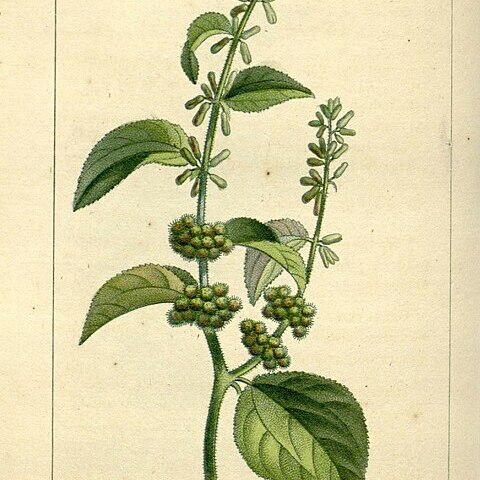Shrub ca. 0.60-2.50 m. high, the branches and inflorescence-axes ferruginous-pubescent. Leaves with a petiole ca. 2-8 cm. long or sometimes slightly more, ferruginous-arachnoid, the blade broadly ovate, sometimes pandurate, often 3-to 5-lobate, the lobe tips, at least the terminal, acuminate, ca. 8-10 cm. long and 7-9 cm. wide, the margins irregularly serrate, the serrations usually glandular, the up-per surface pubescent, the lower one arachnoid to pubescent, 3-to 5-palminerved, the nervation slightly prominent beneath. Inflorescences axillary, the cymes of 2, rarely 3 cymules, generally condensed, the bracts ovate to more or less elliptic, rarely obscurely 3-lobate, the peduncles and pedicels short, 1-2 mm. long, sparsely hirsute. Flowers 4.5-5.5 mm. long, hermaphrodite, the sepals 5, narrowly oblong, acute, with a very short apical appendage ca. 0.5 mm. long, ca. 4.5-5.5 mm. long and 0.5 mm. wide, fleshy, sparsely hirsute without, glabrous within; petals absent; gonophore and urceolus obsolete, the glands absent; stamens (5-) 10(-15), the filaments ca. 3-4 mm. long, glabrous, the anthers ca. 0.5 mm. long; ovary subor-bicular, ca. 0.6-0.8 mm. in diam., covered with numerous uncinate spinules; style ca. 3-3.5 mm. long, the stigma obscurely 2-to 3-parted. Fruit broadly elliptic, the body 3-4 mm. long and 2.5-3 mm. broad, lightly stellate-pubescent, the spines about 50, ca. 1.8-2 mm. long, retrorsely pilosulose, the spinules uncinate, 2-or 3-celled, each cell 1-seeded; seeds pyriform, ca. 1.5-2 mm. long and 1-1.5 mm. wide.
More
A shrub. It can grow to 2.5 m tall. The young branches have rusty hairs. The leaves are simple and alternate. The leaf blades are 3-6 cm long and 2-3 cm wide. They have 3-5 lobes. There are irregular teeth along the edge. The flowering stalks are in the axils of leaves. The fruit are 3-4 mm across.


